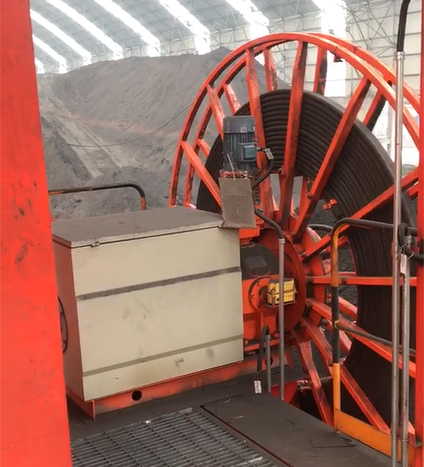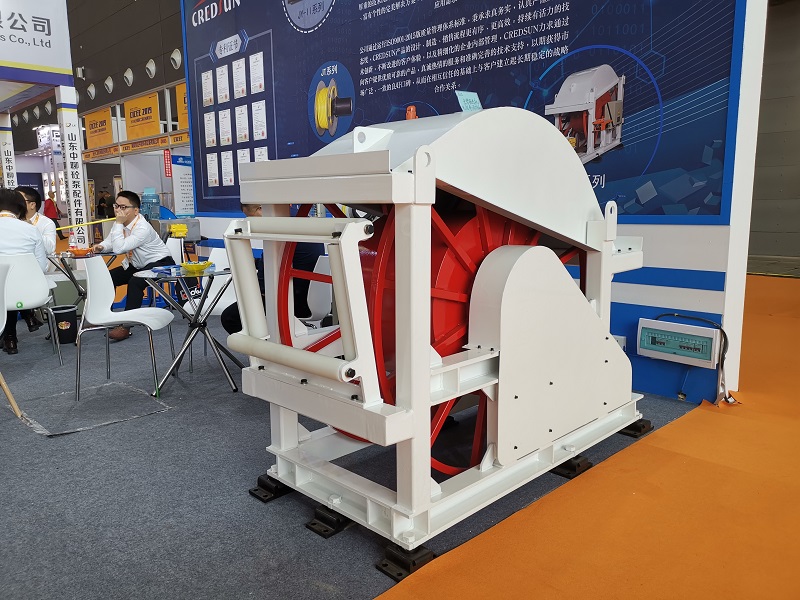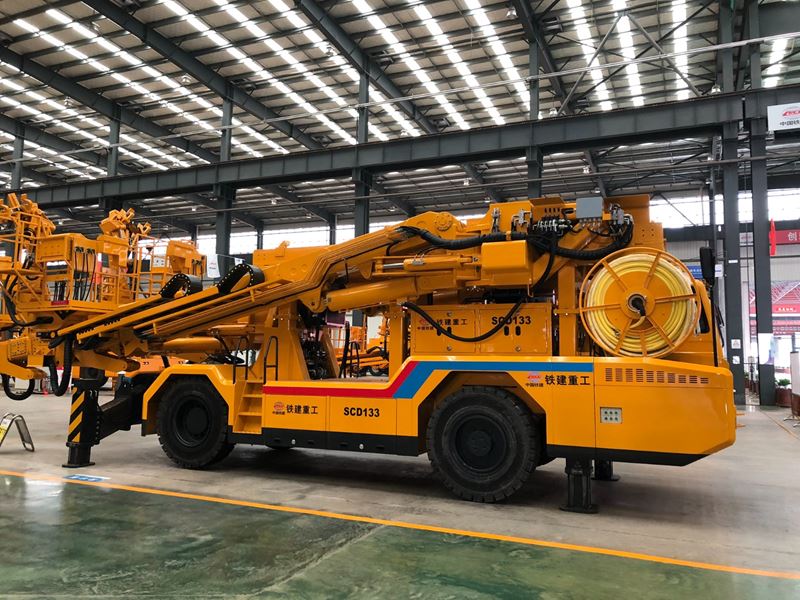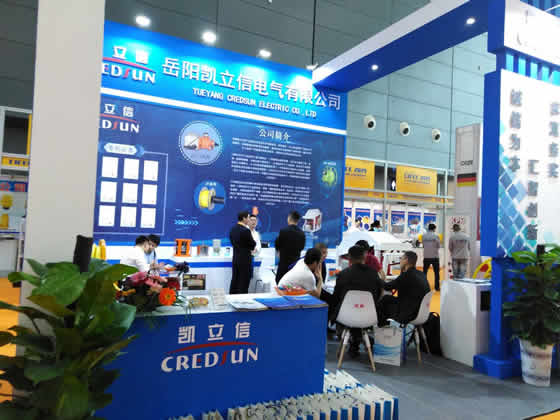-

-
Application of full frequency conversion closed-loop control in the cable reel system of quay crane spreader
摘要:在岸桥吊具电缆卷盘系统中,将原有的磁滞联轴器加变频器驱动模式改造为全变频闭环控制驱动模式,不仅可以缩短卷盘系统的响应时间,提高吊具电缆跟随效果,而且能够改善电缆的受力状况,减少系统设备的维护工作量,提高设备运行的可靠性。关键词:电缆卷盘;全变频;闭环控制;技术改造 岸桥是集装箱码头的主要生产设备,其完好率决定了整个码头的生产效率。吊具电缆卷盘驱动系统是岸桥吊具获取电源、控制信号等能量和信息的唯一通道和关键系统,该系统的工作稳定性、可靠性直接影响到岸桥整机的可靠性。为了确保设备的完好率,减少设备故障,降低设备因素对生产的影响,更好地保护吊具垂缆,我公司对岸桥吊具电缆卷盘驱动系统现有的配置进行了改造,将原有的变频器加磁滞联轴器的驱动模式改造为全变频闭环控制驱动模式,使用一年来效果良好。 一、原吊具电缆卷盘驱动系统简介岸桥吊具电缆卷盘原有的驱动模式为变频器加磁滞联轴器的驱动模式。动为装置为2台380VAC5.5KW三相异步电动机,由变频器驱动三相异步电动机,电动机输出轴端与吊具电缆卷盘的齿轮箱之间采用大扭矩磁滞联轴器连接,以实现动力的传送,见图1。 图1 变频器加磁滞联轴器的驱动模式原理图该驱动模式的主要特点是磁滞联轴器的“软特性”,即联轴器的输入轴与输出轴之间通过磁力连接,在特定的条件下联轴器两端的转速可以不同步。在作业过程中,当吊具提升时,依靠电机的驱动力进行同步收电缆;当吊具下放时,电动机反转下放电缆,依靠变频器对卷盘转速进行控制,确保下放电缆同步;当吊具低速下放时,电动机制动,依靠电缆的自重和吊具的拖拽克服磁滞联轴器的磁力下放电缆。因其“软特性”能缓问吊具升降时对电缆产生的张力,这种变频器回磁滞联轴器的驱动模式已有十余年的使用历史。但该驱动模式亦有如下缺点:1、由于磁滞联轴器的“软特性”,吊具在高速运行的情况下,当吊具下放和上升高速转换的加速度大于0.8m/s2时,系统响应迟钝,电缆跟随效果差,对电缆造成冲击。2、由于吊具电缆卷盘采用大扭矩磁滞联轴顺,当吊具低速下放时,电缆停止动作,磁滞联轴器一端静止,吊一端随电缆下放而转动过时联轴器会因克服磁力而产生大量的热;当吊具高速动作时,主动盘(感应盘)和从动盘(永磁盘)通过磁耦合连接(见图2),主动盘由电缆驱动旋转时,相对磁极错开一个角度,磁力产生扭曲,磁系统位能升高产生切力,牵引从动盘转动。当主动盘与从动盘不同步时,磁力线被切割产生大量热能。两盘的转速差越大,联轴器产生的热量越多,相关零部件温度升高,润滑脂老化,轴承损坏,从而导致整个磁滞联轴器损坏。图2 磁滞联轴器的结构原理图3、采用此种驱动模式时,驱动电机的安装方式为轴向悬挂式,当磁滞联轴器损坏后,极易导致电机损坏。 二、吊具电缆卷盘全变频闭环控制驱动模式简介吊具电缆卷盘全变频闭环控制驱动模式是采用一个380VAC15KW的三相异步电动机,电动机输出轴与吊具电缆卷盘减速箱之间用弹性联轴器连接驱动(见图3)。图3 电缆卷盘全变频闭环控制驱动模式原理图驱动系统采用速度控制、力矩限幅的控制模式,主要由变频调速电机、制动器、减速器、卷筒、吊具、集电器、编码器、电控系统等组成。变频调速电机根据PLC获取吊具提升的高度位置、速度等信息,经自动计算,输出扭矩和转速,通过齿轮箱驱动卷筒运行。在运行过程中不断检测吊具电缆的提升速度和力矩,实时自动修正,形成闭环控制,确保电缆的速度始终准确地跟随着吊具的实际速度并使电缆的受力在合理的范围内。具体工作过程如下:1、吊具起升,电缆卷绕时:吊具上升时,制动器(常闭型)得电打不开,变频调速电机正转,通过弹性联轴器驱动电缆卷筒转动卷绕电缆。PLC通过拾取吊具的起升速度、高度位置信息,自动计算,给定电机转速,在运行过程中,不断检测吊具变频电机的转速,实时修改,保证吊具电缆跟随良好。当发生挂舱事故、吊具上架的缓冲器的行程达到最大时触发信号开关,吊具实施紧停,从而保护电缆不被拉断。2、吊具下降,电缆放缆时:吊具下降时,制动器也得电释放,变频调速电机反转,PLC通过拾取吊具运行速度和高度位置等信息,自动计算给定电机反转转速,同时变频电机保护一定的反转扭矩,保证电缆在下降过程中保护张紧。3、吊具停止,电机停止运行:主系统控制关断,主起升停止,制动器不通电,处于制动状态,能确保吊具电缆不会因自重、风载而下坠。岸桥采用吊具电缆卷盘全变频闭环控制驱动模式具有以下优点:1、全变频闭环控制驱动的吊具电缆卷盘克服了磁滞联轴器的“软特性”,系统响应速度快,电缆跟随效果好。2、卷盘控制采用“速度控制和力矩限幅控制相结合技术”,结合吊具上架的缓冲器过紧限位开关作用,保证电缆在任何工况下不会超过其许用拉力。3、电机采用单台卧式安装变频调速电机,整个传动系统转动惯量小,其应用场合不受电缆自重、起升高度、吊具加速度等限制。4、电机采用弹性联轴器与减速器连接,保养工作量小,维护简单,相应的配件价格低。5、电缆保护:①限制电机给定卷盘的力矩,确保电缆张力小于其许用拉力;②吊架上架的缓冲器安装有过紧限位开关,一旦吊具电缆卷盘收、放缆速度与吊具速度不同步造成的吊具缓冲器的行程达到较大值时,吊具缓冲上的过紧限位触发,电缆过紧信号发出,整个系统做出紧停动作而保护电缆。 三、两种吊具电缆卷盘驱动模式的比较吊具电缆卷盘变频器加磁滞联轴器的驱动模式与全变频闭环控制驱动模式的性能比较见表1。 表1 变频器加磁滞联轴器的驱动模式与全变频闭环控制驱动模式的性能比较比较项目变频器加磁滞联轴器全变频闭环控制驱动电机数量/台≥21是否带增量编码器早期产品不带,现有产品吸有一台电机带有电机与减速器的联接通过磁滞联轴器通过弹性联轴器联接联轴器传动形式磁耦合机械传动(弹性联轴器)制动器安装形式安装在电机尾端,内置式与电机输入同轴系外置式储缆盘形式仅为卷盘式有卷盘和滚筒两种形式控制模式早期产品速度控制开环控制,现在产品速度控制局部闭环速度控制、力矩限幅闭环控制适用范围较大起升高度H≤56m,电缆芯数小于45芯,吊具速度V≤160m/min,加速度a≤0.75m/s2应用的场合不受电缆自重,起升高度、吊具加速度等限制,较大速度可达到240m/min 四、结论实践证明,在岸桥吊具电缆的驱动方案中,全变频闭环控制驱动模式既可以避免传统的垂缆加储缆框模式因大风天气或起升高速运行时导致的电缆钩挂外物而导致电缆损坏的风险,又可以改善变频器加磁滞联轴器的驱动模式下吊具电缆的运行条件,同时避免驱动机构复杂而增加维护保养工作量。...
-

-
Belt conveyor anti-roller clamping device
Our company is a professional wharf for ore loading and unloading operations, and the annual unloading of various types of iron ore reaches more than 35 million tons. The company's mechanical equipment mainly includes three major parts: ship loader and unloader, bucket wheel stacker and reclaimer, and belt conveyor. The belt conveyor is more than 34,000 meters long, which is the link between the ore entering and leaving the port area, and runs through every part of the entire port area. corner.With the rapid development of the company, the requirements for ore throughput and freight quality continue to increase, the number of minerals to be transported continues to increase, and the conveyor belt conveyor is increasingly heavy. When the belt conveyor is transporting minerals with high viscosity and high humidity, the belting and blanking conditions on the return surface are aggravated. When the material is brought to the drum, it will cause the material between the drum and the belt, which will affect the normal operation of the equipment.In order to reduce the harm to the belt conveyor caused by the roller clamping, we have made a set of anti-roller clamping device (see Figure 1), which is installed at the tail roller of our company's BC2 belt conveyor. It was converted from a discarded sweeper. There is a small gap between the polyurethane scraper of the cleaner and the belt at the drum. When the material is clamped at the drum, the belt will bulge, and the belt will collide with the scraper of the cleaner, so that the cleaner has a small angle. Turning, at this time, the contacts fixed on the cleaner are in contact with the contacts of the protection switch installed at the back, so that the protection switch is activated, and the signal of the switch is connected to the operation process signal. After the switch is activated, the process stops immediately, and the cleaning personnel clean up the material clamped at the drum before restarting the process. This device can timely find the clamped material or foreign matter at the drum, so that it can be dealt with in time, which can greatly reduce the hidden danger of accidents.After the BC2 belt conveyor is installed with the anti-roller clamping device, the accident rate of the drum clamping is greatly reduced, and the belt is well protected....
-

-
Design of Automatic Power-taking Device for Cable Reel of Rubber Tyred Gantry Crane
摘 要:介绍了一种能够将轮胎式龙门起重机电缆卷筒上的电缆插头与插座固定电箱进行自动插拔的一种技术,摆脱了目前港口起重机转场作业时进行人工手动插拔电缆插头的局面,提高了港口的工作效率和安全性。关键词:轮胎式龙门起重机;转场作业;电缆卷筒;自动插拔。 0 引言轮胎式龙门起重机是目前港口码头堆场的主要设备,由于目前日益高涨的油价和低碳环保意识的增强,该起重机的油改电范围也越来越广,即用柴油发电机供电改为市电供电。目前,大车采用电缆卷筒式供电是经济、安全的一种方式,电缆通过电缆卷筒的收放与龙门起重机进行同步移动,达到移动供的效果,然而在起重机需要转场作业时,必须要人工将电缆插头从插座拔出,并在起重机到另一个新场地后,再重新将插头与插座固定在电缆箱连接。这种人工插拔方式存在安全隐患,工作效率也比较低。为改变这一落后的工作模式,电缆自动插拔技术越来越受到重视和期盼。电缆插头自动插拔技术是将原来的人工插拔改为自动插拔,即起重机司机在场地的指定地点能过远种一键式操作对电缆插头与插座电箱进行自动插入和拔出,实现自动插拔,大大提高了作业效率和安全性。1 起重机转场对电缆自动插拔的要求 自动插拔包含起重机转场前的自动断电和入场后的自动取电,首要的步骤是对位问题,因起重机体形的庞大,操作司机不可能将电缆插头和插座箱进行精确定位,因此,自动取电缆装置必须有二次自动对位的功能来纠正司机一次对位时的误差。其次是将电缆插头与插座箱可靠地插入或拔的动作。在完成插入后必须保证电缆插头与插座箱可造地锁定,并与插座保护良好的接触,使起重机行走时插头不被电缆的冲击拉力拉出。2 电缆自动插拔的设计原理电缆插头自动插拔主要由精确对位、自动插拔和自动锁定3部分组成,原理为:司机将带有自动取电装置的起重机驶入堆场指定的区域,允许起重机在停车位水平和垂直方向有一定的误差。借助设置的信号反馈使在车停车后,自动取电装置会自动根据停车位置来判断插头与插座箱的相对位置,通过自身的PLC程序计算,对执行元件给出命令,将插头和插座箱进行二次精确对位。然后自动取电装置手机构将插头与插座箱进行精确插拔,在机械手释放插头并收回的同时,插头被插座箱自动地锁定。这样便完成自动取电操作。此时,司机可以将非市电操作切换到市电工作模式,进行市电作业。在起重机要转场到其他场地时,司机需将起重机开到原指定的区域进行自动断电操作,对位步骤与上述相同,然后是机械手自动将插头从插座箱解锁并拔出收回,起得机可作转场作业。自动插拔装置结构见图1。2.1 自动取电的操作自动插拔装置操作示意图见图2。 1)大连到指定区域有反馈信号时停电,自动取电装置自动对插座箱对位;2)完成对位后机械手作自动取电操作。3)插头与插座接触到位后,机械手自动解锁;4)机械手完成解锁后自动退出;5)机械手退出到位时防雨罩自动关闭;6)机械手自动上升到位,基座复位到对中位取电动作完成,轮胎起重机进场作业。2.2 自动断电的操作 按上述2.1步骤作断电操作。2.3 电控系统 动力取电装置的电控采用先进的PLC逻辑控制技术,具有自动定位、测距、补偿功能;故障保护、自诊断显示功能;远程监控和修复功能。2.4 主要技术参数主要技术参数见表1。项 目规格参数允许轮胎式龙门起重机停车左右偏差±160mm允许轮胎式龙门起重机停车角度偏差±3°自动取(断)电时间3min插座箱绝缘水平3000V/1 min无击穿、无闪络.适应操作工况间断工作制,一连连续操作≤3次。整机防护等级IP56,可适用于户外环境。 3 自动取电装置的市场价值目前,该技术已经获得专利,并在福建江阴、广东惠州、大连等码头进行作业运行,使用效果得到了用户的肯定。此装置能取消原人工插拔的作业方式,不仅提高了码头作业效率,节约了人工成本,同时避免了人工插拔的安全隐患。此套技术也是目前唯一一种用于电缆卷筒电缆自动插拔的技术,在未来的推广中有很大的应用价值和市场空间。...
-
-
Development of anti-rolling protection device for power supply cables in multi-functional portal crane wharf
能用码头上的多功能门机大多采用380V、50Hz的低压交流电源,将设在码头海地面电源箱中的电源,通过装在海侧门腿上的磁滞式电缆卷筒引缆上机。我港8#泊位码头原设计为通用泊位,码头上配备有4台多功能门机,自2006年投入使用以来,先后发生过6起码头供电电缆被行走台车轧破的事故,造成门机长时间故障停机,严重影响安全作业,同时造成较大的材料浪费。1、原因分析为解决这一问题,我公司组织技术力量对门机磁滞式供电电缆卷筒驱动装置、门机行走台车结构以及门机行走过程中供电电缆工况等进行了分析,发现门机供电电缆被行车轧破主要有2个原因:一是多功能门机的2个行走台车之间有一段近2米的间距,而每个行走台车下端面与码头平面之间有较大空隙(该间隙大于供电电缆的直径);二是在门机行走过程中,当磁滞式供电电缆卷筒驱动装置等突然发生故障后,导致供电电缆不能正常卷入电缆卷筒内,而是凌乱地散落在码头上,此时司机往往不能及时发现,而是继续操作门机行走,这样供电电缆就可能通过台车与台车之间的间隙落到门机轨道上,或通过行走台车下端面与码头平面之间的空隙被挤入台车与轨道之间,导致电缆被轧破。2、技术改造根据上述分析,我们确定了技术改造的方案,即研制码头供电电缆防轧保护装置,着重从两方面入手:一是增加供电电缆卷筒驱动装置故障报警功能;二是对行走台车结构进行改进,确保在任何情况下供电电缆都不能进入轨道上或进入行走台车与轨道之间。2.1 加装门机供电电缆卷筒驱动装置工作异常报警装置虽然不能确保磁滞式电缆卷筒驱动装置不发生故障,但是我们要求当电缆卷筒驱动装置发生故障后能够及时报警,以提醒司机停止继续操作门机行走或要密切关注供电电缆状况。从这个思路入手,我们研制了1种新型的磁滞式电缆卷筒驱动装置工作异常时可以报警的装置。具体方案如下:首先在供电电缆卷筒驱动装置旁边安装1只PSN40-20DP常开式电感型接近传感器(安装位置见图1),用卷筒支架的多个撑杆作为检测物,并通过PLC程序检测脉冲的时间来判断电缆卷筒是否正常运转。正常运转过程中PLC程序检测电缆卷筒撑杆运转时1组通、断的方波时序图(见图2,图中“Z”为支架处,“K”为空档处),通过比较通、断电时间的长短来判断电缆卷筒收放缆线是否正常。根据时间最短原则,在最短时间内检测不到信号,就立即输出报警。当供电电缆卷筒不工作、传感器对准的是撑杆时,传感器接通中继,正常情况下接通时间小于1s,设定时间为2s,如果接通时间2s,就认为电缆卷筒工作异常;当传感器停在空挡处时,正常情况下传感器断开时间(传感器不输出信号)为1.5s左右,考虑到在电箱处有换向,将断开时弊设定为4s,如果超过4s传感器仍未检测到信号,就认为供电电缆卷筒工作异常,输出报警10s。2.2 在门机海侧行走台车上安装挡缆装置为确保供电电缆在任何情况下都不能进入轨道面上或被挤入台车与轨道之间,我们重点从缩短门机中间2个行走台车之间的间距和减小台车下端面与码头平面之间的空隙入手,在行走台车端面和台车侧面安装了1套挡缆装置,具体方案是,用直径为40mm的圆钢焊接于海侧各行走台车外侧下部,安装空间为下部距离码头平面3cm。同时,使用加厚胶带制作支架安装在海侧行走台车端面,防止在电缆驱动装置工作异常后卷绕的电缆进入门机轨道面上,同时也起到了清轨器的作用。3、改造效果根据上述方案,我们先选择1台门机进行了尝试,成功后进行推广。该方案的实施,成功地解决了供电电缆被行走台车轧破的问题,具体效果如下:⑴ 报警装置安装完成后,门机行走过程中多次发生供电电缆卷筒驱动装置工作异常,但由于能够及时报警,司机能够及时进行处理,所以保证了电缆的安全使用。⑵ 多功能门机电缆挡缆装置安装以后,现场使用情况良好,即使在人为设定电缆驱动装置故障的条件下,挡缆装置也能够完全消除电缆进入门机轨道上或进入轨道与行走台车之间被轧破的情况。⑶ 供电电缆防轧保护装置投入使用近2年多以来,4台多功能门机供电电缆再未发生过被轧破的事故。...
-

-
Integrated Solution of Power Supply and Water Supply for Mobile Bulk Yard Machinery
In the process of material handling, dust will be inevitably produced by the mobile bulk yard machinery, and this is criticized for the increasing requirements of environmental protection currently. The equipment managers have been using methods such as dry method, dry mist or spraying method to cloud vacuum or press dust, but due to problems in cost, environment, technology and many other aspects, the above methods have not been used normally. At present, the issue of environmental protection has been upgraded to an issue related to the people's livelihood, which has received great attention from the state. Dust generated by the materials on mobile bulk yard machinery must be effectively dealt with. Due to the high investment cost and use cost and high failure rate of dry dust removal, general users will not accept it. Although dry mist and spraying methods are feasible dust control methods, they need to rely on water resources to solve the problem of water supply on the machine, which must be realized with the help of external equipment. This article discusses the power supply problem while discussing the water supply method, which is helpful to analyze the advantages and disadvantages of each solution.1. Solution to power supply and water supply for mobile bulk yard machineryThere are three kinds of power supply and water supply solutions for mobile bulk yard machinery: cable reel + water cable drum, cable reel + ground water tank, and integrated power supply and water supply with drag chain.1.1 Solution to power supply with cable drum reel + water supply with water cable reel (drum)In this solution, the mobile equipment is supplied power and water through cable reels and water cable reels (drums) respectively. These two systems are relatively independent. Power supply with cable reel is a conventional method for power supply. If the cable adopts the form of two-in-one or three-in-one, only one cable reel is required; if the power and control are separated, there are power reels and control reels respectively. If the equipment traveling distance is not long, the water cable reel can be used for water supply; if the equipment traveling distance is long, the water cable drum is needed for water supply. In terms of the overall solution of power supply and water supply, this method requires sufficient installation space on the machine. There are also many ways to drive the reel, such as hysteresis, torque motor, and frequency conversion ways, which involves many parts, including motor, reducer, coupling, slip ring box and optical cable coupler, which also means more failure points. In addition, the cable and water cable need to be maintained a certain tension in the coiling process. Otherwise, in cold seasons and regions, the cable or water cable is easy to be fractured.1.2 Solution to power supply with cable reel + water supply with ground water tankIn this solution, the mobile equipment is supplied power and water through cable reels and ground water tanks respectively. These two systems are relatively independent. The power supply method of the cable reel is the same as that in Section 1.1. According to customer requirements, power / control cable reel or two-in-one / three-in-one cable reel is used for power supply. This part of the cable may be affected by seasons and regions, resulting in cable fracture. The water supply method in this solution adopts ground water tanks, which is more conducive to continuous water supply than the water cable reel method, but there is a sealing problem of the water tank. Since there are dust particles floating in the atmosphere at the scene, they are likely to fall into the tank, and over a long time, the dust will accumulate and is more difficult to clean. In cold seasons and regions, the heat preservation of the water tank is also a problem, and it is necessary to avoid the problem of water freezing when the temperature is below 0℃. In addition, it is also faced with the adaptability of foundation settlement.1.3 Integrated solution of power supply and water supply with drag chain systemThis solution is to integrate the power supply and water supply of the equipment into one by using a set of drag chain system. As we all know, the drag chain system originated in the machine tool industry as a mobile power supply method. As a machine tool accessory, the drag chain product made of engineering plastics is designed and produced to protect the pipelines of different media required by various moving mechanisms of machine tools. As the functions of engineering-plastic drag chain are recognized and various advantages are found, the drag chain system today is found in almost all walks of life, such as crane, metallurgy, shipbuilding, automobile, entertainment, logistics, automation, aerospace, energy, and marine engineering. Compared with the traditional mobile power supply system such as festoon, drum and sliding wire, the unique advantage of the drag chain system is that it can integrate all kinds of media and needs to achieve all requirements. Whether it is high pressure, low pressure, control, data, optical cable or water pipe, gas pipe and hydraulic pipe, all functions can be achieved through one system.The drag chain system itself does not need power, and there is no driving mechanism. The drag chain is driven by the power of the traveling mechanism, so there is no need to consider the installation of the equipment. At the same time, it has better protection for cables and water cables, which improves the reliability of power supply and water supply, reduces maintenance downtime caused by failure and improves equipment utilization. On the other hand, the tow chain system is easy to be maintained with less workload. The drag chain system eliminates the need for two-in-one or three-in-one cables, greatly reducing the risk and cost of cable replacement. Of course, if there is more equipment on the track, the space that needs to be arranged will be larger, which is the disadvantage of the drag chain system.With the development of automation technology, more and more terminals are realizing or preparing to realize automation, which requires equipment-related accessories or mechanisms to have high reliability, less maintenance workload and good controllability. The drag chain system can also use PPDS and other functions to monitor the running state of the drag chain in real time.Many years ago, an integrated solution of power supply and water supply was provided for a coal terminal of a foreign power plant. The drag chain system for power supply and water supply of this equipment not only includes water pipes, but also power cables, control cables and optical cables. After more than 10 years of use, it still has high reliability and less maintenance workload. The customer is very satisfied with this integrated solution, and all equipment of the subsequent terminals adopts this integrated solution.2. Comparison of three solutions to power supply and water supply for mobile bulk yard machinery The above three solutions have their own advantages and disadvantages. Customers need to choose the most appropriate solution according to their own situation with overall consideration of various factors. See the following table for the advantages and disadvantages of the three solutions Solution to Power Supply with Cable Reel + Water Supply with Water Cable Reel (Drum)Solution to Power Supply with Cable Reel + Water Supply with Ground Water TankIntegrated Solution of Power Supply and Water Supply with Drag Chain SystemUpfront Investment CostMediumHighMediumLater Maintenance CostMediumHighLowReliabilityMediumMediumHighSpace Occupied on MachineLargeSmallSmallSpace Occupied by FoundationSmallLargeLargeCable ProtectionGeneralGeneralGoodWater Cable ProtectionGeneralNoneGoodEnergy ConsumptionHighMediumNone 3. ConclusionThe environmental protection situation is becoming more and more severe, and the water supply of mobile bulk yard equipment has become indispensable. Based on the above analysis, the integrated solution of power supply with the drag chain system is better. In the life cycle of the equipment, its cost is the lowest, the reliability is the highest, and the maintenance is the least. It is hoped that users can fully consider these key indicators when choosing a solution and make the right choice.Abstract: Hoisting and Conveying MachineryJuly 2018...
-

-
Summary of Anti-corrosion Methods for Surface of Lifting Appliances
In recent years, with the development of domestic engineering construction, the lifting appliances is more and more widely used in modern production such as ships, aerospace, electric power, base materials, metallurgy, bridges and railways. The increase in the number of cranes has brought opportunities to manufacturing enterprises, as well as many challenges. According to authoritative statistics, while the number of cranes in China is increasing year by year, the number of cranes dismantled and scrapped each year is also increasing significantly, of which more than 80% of cranes are scrapped caused by corrosion failure of their metal structures. Because of the high frequency of use of lifting appliances and the relatively harsh working environment, it is often laid aside in the open air or humid and corrosive environment, and the protective layer of its skin paint often loses its protective function due to damage, thus causing the metal structure being corroded. In Zaozhuang City, there have been two cases in which the main stress components of gantry cranes were severely corroded, and the users were forced to use the cranes under overload in violation of regulations, resulting in the damage of metal structures and the accidents of machine damage and human death. The situation abroad is also not optimistic. According to statistics of the developed country America, about 50 people are killed by crane accidents every year. Corrosion of metal structure materials of lifting appliances not only easily causes safety accidents, but also causes huge waste of metal materials. Article 3.9 of Safety Rules for Lifting Appliance - Part 1: General Provisions (GB6067.1-2010) clearly stipulates that when the main stressed components of cranes are corroded, they shall be inspected and measured. When the cross-section corrosion of the main stressed component reaches 10% of the design thickness, it shall be scrapped if the repair effect is poor.Therefore, how to improve the anti-corrosion performance of crane metal structure and reduce the energy consumption of crane in harsh environment is an urgent problem to be solved at present. In addition, the reference[6] mentioned that the metal structure of the lifting appliances serving in harsh environment such as stone processing base and strong chemical corrosion environment can hardly reach the expected life if ordinary paint are used for their metal structure, which further shows that the paint can hardly meet the anti-corrosion requirements of cranes in harsh environment. In conclusion, it is of great significance to study the applicable surface protection treatment technology of lifting appliances, delay its corrosion rate and prolong its service life.Based on the analysis of the protection methods of crane metal structures at home and abroad and related research, this paper proposes a new protection technology for metal structures of heavy machinery, which can effectively prolong the service life of crane metal structures, save the production cost of replacing cranes, and at the same time promote the innovation ability of crane manufacturers in this field.1. Corrosion and Cause Analysis of Metal Structure of Lifting AppliancesThe main girder and other main parts of the lifting appliances are mainly made of ordinary carbon steel Q235, and Q235B, Q235C and Q235D are required for the important load-bearing components of the crane metal structure. For the general lifting appliances metal structure, boiling steel Q235F is allowed when the design temperature is not lower than -25°C. Corrosion forms of ordinary carbon steel can be divided into uniform corrosion, pore corrosion and intergranular corrosion. The harmfulness of uniform corrosion is low. Because metal components have a certain cross-sectional size, slight uniform corrosion generally does not significantly reduce the mechanical properties of metals. However, if a layer of "skin" is removed from the inner cavity surface of the box-shaped metal structure (box beam, box leg, box arm, etc.) of lifting appliances, the web plate and arm plate structure will become thinner, which will easily lead to safety accidents. The uniform corrosion is shown in Fig. 1a. Pore corrosion and intergranular corrosion are the local corrosion of metal bodies. These two kinds of corrosion will reduce the effective cross-sectional area of components, and make the parts easily break suddenly. These two kinds of corrosion behaviors are much more harmful, as shown in Fig. 1b and Fig. 1c. The research shows that intergranular corrosion is mainly caused by the residual stress inside the material or the stress exerted by the outside, which causes the material to be damaged by the combined action of stress, strain and corrosion, and this kind of corrosion will lead to extremely serious damage and failure of metal structures.The corrosion mechanism of metal structure of lifting appliances mainly includes chemical corrosion and electrochemical corrosion. Chemical corrosion refers to the destruction of materials caused by pure chemical corrosion between materials and non-conductive media directly, while electrochemical corrosion is the most common and important corrosion type of metal materials caused by electrochemical reactions. Under normal environment, the surface of lifting appliances steel structure generally generates iron rust Fe3O4 and Fe2O3. However, at high temperature, iron oxide FeO is easily formed in steel structures. In addition, Fe3C structure in iron and steel easily reacts with gas at high temperature as followsFe3C+ O2=3Fe+ CO2↑Fe3C+C O2=3Fe+ 2CO↑The generated gas escapes from the steel surface, and the decarburized layer is formed on the surface of the steel structure, thus affecting the service performance of the lifting appliances. In harsh environment, the three conditions necessary for electrochemical corrosion are easy to be met: existence of potential difference, electrolyte solution, and contact. As long as the above three conditions are met at the same time, electrochemical corrosion can be formed, thus destroying the metal structure of lifting appliances.2. Analysis of Metal Structure Protection Methods of Lifting AppliancesAt present, the main anti-corrosion methods of crane metal structure involve metal structure surface coating and sacrificial anode protection method. Sacrificial anode protection method usually adds filler (such as zinc) with higher activity than steel in coating, which can protect metal structure from corrosion by sacrificial anode through electrochemical principle. Although this method does not need external power supply, it requires extremely high quality of anti-corrosion coating, consumes non-ferrous metals, and requires periodic anode replacement, resulting in high cost and complicated process. Surface coating methods are mainly divided into corrosion-resistant metal coating method and nonmetal coating method. Corrosion-resistant metal coating method generally includes electroplating method, cladding method, hot plating method, infiltration plating method and spraying method, etc. These methods feature high technological requirements and high cost, and are suitable for small workpieces. However, for large-scale lifting appliances that has been put into practical application, these methods are beyond the reach of the above methods, so they are not widely used. Nonmetal coating method is to smear the metal surface with basic antirust paint. This method is of cost efficiency and easy to operate. Although it is widely used for crane corrosion prevention, a single paint film can not completely impede the technological difference between water and oxygen, which will lead to a poor long-term effective protection of the paint. In the research of nonmetal coating method, Wang Hongfeng, et al. analyzed the specific causes of corrosion of metal structures of lifting appliances, and put forward a new paint coating process, but this method can only increase the corrosion resistance life of lifting appliances to about 5a. It can be known that the protection methods mentioned above have their own advantages and disadvantages. At present, it is impossible to find an effective anti-corrosion method for the metal structure of lifting appliances.3. Application and Analysis of Spray Polyurea Elastomer TechnologyThermal spraying technology has developed rapidly, and has been widely used in many engineering fields as a material surface improvement technology. By using this method, the prepared material is added into spraying equipment, heated to semi-molten or molten state, and then sprayed onto the selected substrate surface with a spray gun to form a coating film. Part of properties of this coating are better than those of the substrate, so it can effectively improve the surface properties of the substrate material, or provide the substrate material with several more coating film-like structures. Spray polyurea elastomer (SPUA) technology is one of them. SPUA technology is a new solvent-free and pollution-free green construction technology developed abroad in recent ten years, which meets the current national policy requirements on ecological environment protection, energy saving and emission reduction. The appearance of SPUA technology provides a new material and construction technology for the anti-corrosion field, and also proposes a new chose for engineering application. Polyurea elastomer is a new type of universal coating material, which integrates plastics, rubber, coatings, glass fiber reinforced plastics, etc. Compared with other traditional coatings, it has obvious performance advantages: if it does not contain catalyst, it can be cured quickly, and it will not produce flowing phenomenon when sprayed on any surface; Good construction performance, low cost, suitable for large-area coating; The coating is dense and seamless, resistant to long-term corrosion by medium such as acid, alkali, salt and oil, as well as UV aging; It will have no cracking after long-term outdoor use. Its advantages and disadvantages compared with traditional coating technology are shown in Table 1.In the research of spray polyurea elastomer (SPUA), Fedotova, a Soviet scholar, studied the synthesis of polyurea in 1960s. By the mid-1980s, Primeaux, a famous chemical expert, first successfully developed SPUA technology. This technology was put into use in some States and districts of the United States in the early 1990s. Because of its excellent comprehensive performance, it was widely welcomed by enterprises and users. Then, South Korea and Japan also introduced SPUA technology and put it into research and application successively. China introduced this spraying equipment in 1997, and developed a series of products with independent intellectual property rights, such as wear-resistant, anti-corrosion and flexible anti-collision materials. At present, domestic research mainly focuses on the practicability of polyurea coating. Sun Zhiheng, et al. put forward the polyurea elastomer technology, which has excellent anti-corrosion, wear-resistant and anti-seepage effects and has been widely applied water conservancy construction projects in China. The exploration and research on many key technologies such as polyurea coating technology of lifting appliances in China are still not perfect, and the related research reports are very few. The related research has only been done on the mechanical properties of crane metal structure after spraying polyurea coating. The results show that when the thickness of polyurea coating is 0-0.6mm, the tensile strength, maximum stress, area shrinkage and surface hardness of polyurea coating gradually increase. However, when the thickness is greater than 0.6mm, the surface hardness of the coating is basically unchanged, and the tensile strength and maximum stress gradually decrease. If polyurea coating is to be industrially applied in the field of lifting appliances, domestic experts and scholars should also make further research on the corrosion resistance and degradation behavior of the coating.Table 1 Advantages and Disadvantages of Polyurea and Other Coating TechnologiesItemSolid paintWater paintUV paintPowder paintPolyurea paintAnticorrosion PerformanceGoodCommonCommonExcellentExcellentSuitable SubstrateUnlimitedUnlimitedWoodMetalUnlimitedConstruction Environment0°CAbove 5°CInside the plantInside the plantUnlimitedOne-off film thickness≤150≤100≤50≤800Unlimited 4. ConclusionWith the progress of the times and the development of science and technology, according to the data of Analysis Report on Market Demand Forecast and Transformation and Upgrading of China's Crane Manufacturing Industry in 2015-2020 released by Preoperative Industry Research institute, after 2015, the whole crane manufacturing market gradually has been picked up, with a compound annual growth rate of 6.96%. By 2020, with the aging of the previous wave of cranes and the opening of various domestic large-scale projects, the sales volume of cranes will be close to 44,000 units. Besides, the research on the surface protection treatment technology suitable for lifting appliances to improve the service life of crane metal structure can not only save the production cost of replacing cranes, but also improve the competitiveness of crane manufacturers in the field of cranes. By analyzing the corrosion mechanism of lifting appliances and the shortcomings of current anti-corrosion methods, this paper puts forward a new type of metal structure protective coating for lifting appliances, and points out the current status and development direction for domestic and foreign research. According to the domestic energy saving and emission reduction policy, it is imperative to improve the anti-corrosion performance of cranes and promote the technological progress of domestic crane industry. SPUA anti-corrosion technology will have broad prospects in the crane industry....


